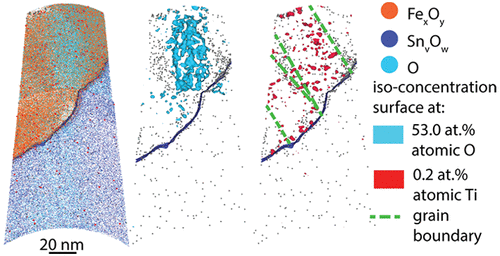当前位置:
X-MOL 学术
›
Chem. Mater.
›
论文详情
Our official English website, www.x-mol.net, welcomes your
feedback! (Note: you will need to create a separate account there.)
Defect Segregation and Its Effect on the Photoelectrochemical Properties of Ti-Doped Hematite Photoanodes for Solar Water Splitting
Chemistry of Materials ( IF 7.2 ) Pub Date : 2020-01-21 , DOI: 10.1021/acs.chemmater.9b03704 Barbara Scherrer 1 , Tong Li 2, 3 , Anton Tsyganok 1 , Max Döbeli 4 , Bhavana Gupta 5 , Kirtiman Deo Malviya 1 , Olga Kasian 3 , Nitzan Maman 5 , Baptiste Gault 3 , Daniel A. Grave 1 , Alexander Mehlman 1 , Iris Visoly-Fisher 5 , Dierk Raabe 3 , Avner Rothschild 1
Chemistry of Materials ( IF 7.2 ) Pub Date : 2020-01-21 , DOI: 10.1021/acs.chemmater.9b03704 Barbara Scherrer 1 , Tong Li 2, 3 , Anton Tsyganok 1 , Max Döbeli 4 , Bhavana Gupta 5 , Kirtiman Deo Malviya 1 , Olga Kasian 3 , Nitzan Maman 5 , Baptiste Gault 3 , Daniel A. Grave 1 , Alexander Mehlman 1 , Iris Visoly-Fisher 5 , Dierk Raabe 3 , Avner Rothschild 1
Affiliation

|
Optimizing the photoelectrochemical performance of hematite photoanodes for solar water splitting requires better understanding of the relationships between dopant distribution, structural defects, and photoelectrochemical properties. Here, we use complementary characterization techniques including electron microscopy, conductive atomic force microscopy (CAFM), Rutherford backscattering spectroscopy (RBS), atom probe tomography (APT), and intensity-modulated photocurrent spectroscopy (IMPS) to study this correlation in Ti-doped (1 cat. %) hematite films deposited by pulsed laser deposition (PLD) on F:SnO2 (FTO)-coated glass substrates. The deposition was carried out at 300 °C followed by annealing at 500 °C for 2 h. Upon annealing, Ti was observed by APT to segregate to the hematite/FTO interface and into some hematite grains. Since no other pronounced changes in microstructure and chemical composition were observed by electron microscopy and RBS after annealing, a nonuniform Ti redistribution seems to be the reason for reduced interfacial recombination in the annealed films, as observed by IMPS. This results in a lower onset potential, higher photocurrent, and larger fill factor with respect to the as-deposited state. This work provides atomic-scale insights into the microscopic inhomogeneity in Ti-doped hematite thin films and the role of defect segregation in their electrical and photoelectrochemical properties.
中文翻译:

缺陷离析及其对掺钛赤铁矿光阳极用于水分解的光电化学性能的影响
优化赤铁矿光阳极用于太阳能水分解的光电化学性能需要更好地了解掺杂剂分布,结构缺陷和光电化学性质之间的关系。在这里,我们使用互补的表征技术,包括电子显微镜,导电原子力显微镜(CAFM),卢瑟福背散射光谱(RBS),原子探针层析成像(APT)和强度调制光电流光谱(IMPS),来研究掺钛的这种相关性(1 cat。%)通过脉冲激光沉积(PLD)在F:SnO 2上沉积的赤铁矿薄膜(FTO)涂层的玻璃基板。在300℃下进行沉积,然后在500℃下退火2小时。退火后,通过APT观察到Ti偏析到赤铁矿/ FTO界面上并析出一些赤铁矿晶粒。由于退火后,通过电子显微镜和RBS观察不到微观结构和化学成分的其他明显变化,因此,如IMPS所观察到的,Ti的不均匀分布似乎是退火膜界面重组降低的原因。相对于沉积状态,这导致较低的起始电势,较高的光电流和较大的填充因数。这项工作提供原子级的见解,以了解掺钛赤铁矿薄膜的微观不均匀性以及缺陷偏析在其电和光电化学性质中的作用。
更新日期:2020-01-22
中文翻译:

缺陷离析及其对掺钛赤铁矿光阳极用于水分解的光电化学性能的影响
优化赤铁矿光阳极用于太阳能水分解的光电化学性能需要更好地了解掺杂剂分布,结构缺陷和光电化学性质之间的关系。在这里,我们使用互补的表征技术,包括电子显微镜,导电原子力显微镜(CAFM),卢瑟福背散射光谱(RBS),原子探针层析成像(APT)和强度调制光电流光谱(IMPS),来研究掺钛的这种相关性(1 cat。%)通过脉冲激光沉积(PLD)在F:SnO 2上沉积的赤铁矿薄膜(FTO)涂层的玻璃基板。在300℃下进行沉积,然后在500℃下退火2小时。退火后,通过APT观察到Ti偏析到赤铁矿/ FTO界面上并析出一些赤铁矿晶粒。由于退火后,通过电子显微镜和RBS观察不到微观结构和化学成分的其他明显变化,因此,如IMPS所观察到的,Ti的不均匀分布似乎是退火膜界面重组降低的原因。相对于沉积状态,这导致较低的起始电势,较高的光电流和较大的填充因数。这项工作提供原子级的见解,以了解掺钛赤铁矿薄膜的微观不均匀性以及缺陷偏析在其电和光电化学性质中的作用。











































 京公网安备 11010802027423号
京公网安备 11010802027423号